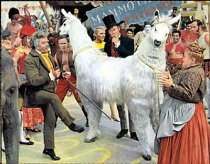This piece was guest-authored by Jess Upson who is studying Biology at Oxford Brookes University
Listen to my BBC radio chat with Malcolm. We discuss Chaser the Border collie and animal languages starting 50 seconds of ridiculous intro chat in this clip:
[audio http://www.brookes.ac.uk/lifesci/runions/DrMolecule/20130528%20-%20Animal%20languages%20and%20white%20tigers.mp3]
It has long been thought that we humans are ‘top-dog’ with regards to intelligence and communication, but it has recently been discovered that animals may not be as dim-witted as we sometimes give them credit for.
It turns out that if I call you ‘bird-brained’ this may not be so offensive… Recent studies have shown that crows are one of the most intelligent animals on the planet, demonstrating extraordinary abilities of creative problem solving. These breakthroughs are beginning to shed light on how the brains of many animals work and, as much as we feel so superior, they work not unlike our own.
One of the best ways to understand the mind of an animal is observe how they behave with others of their kind. From a bee’s waggledance which tells others where the best flowers are, to the pops and whistles of dolphins whilst playing, there are a variety of mechanisms used by animals for communication. Perhaps one of the most exciting ideas is the idea that animals having a language of their own.
Studies now demonstrate that animals may communicate in what could be considered a language. A mother and infant dolphin talked over the telephone when placed in different enclosures. Elephants have also been known to demonstrate a sophisticated way of communicating, with each individual producing a unique noise, often in the sub-sonic range that humans can’t hear, and it can travel for miles. The matriarchal female can recognize hundreds of calls from elephants she knows and from huge distances away – that is the equivalent of being able to stand blindfolded in the middle of 1000’s of screaming people – like outside of One Direction’s hotel – and still being able to distinguish the ones you know!
But it is not just the larger mammals that can demonstrate this. Work carried out on prairie dogs has shown their ability to produce effective warning calls, with all the details included. It was discovered that each predator had a unique call associated with it, including humans. The call could tell other individuals what the threat was as well as information like its colour and size. When a new object was placed within sight of different groups of prairie dogs, each came up with the same new warning call, showing that there may be something within their culture, a language perhaps, which allows them to convey this sort of information.
So,it is not just humans who have shown the ability to understand different forms of communication. Famously, Panzee the chimpanzee can distinguish more than 130 human words. But it looks like there is a new champion at understanding human-speak, Chaser the Border collie.Tell your dog a simple command and it may respond, but no dog has yet quite matched the ability of Chaser when it comes to understanding our language. Chaser knows the name of every single one of her toys – all 1022 of them! She also understands verbs and conjugate sentences. That’s better than I can do some mornings…
Chaser goes beyond remembering words. She can correctly respond to phrases with three parts (a noun, a verb, and another noun) 75% of the time. This sort of ability is learnt at about the age of three in humans.
It is a baffling question that if we are so ‘intelligent’, why can’t we understand animals when many appear to be able to understand us? But the mechanisms used by different animals to relay information are vast and often very complex. A dolphin clapping its fins could mean multiple things depending on the situation. For example, if you put a hand in the air it could mean you were greeting someone, or waving goodbye, or even indicating the number five, all depending on the situation.
Many animal species have vocal cords that are used for making sounds. During evolution of human speech, we have developed the ability to modulate those sounds using out tongues, lips and larynx. Many scholars are actively engaged in trying to determine how and when in our evolutionary history we developed this extrorinary ability that sets us apart from other animals, including those like the great apes who possess vocal cords.
Some still argue that the idea of species other than humans communicating through a language is far-fetched. But we are only just beginning to understand the subtlties and intricacies of animal communications. So is animal language really as fictional as Dr Doolittle’s Pushmi-pullyu?



